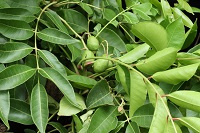Antimicrobial and Phytochemical Screening of the Leaf and Stem Bark Extracts of Spondias Mombin
Keywords:
Spondiasmombin, Inhibition, bioactive, Phytochemicals, pathogenic microorganismsAbstract
Ethnobotany has brought about the rudimentary drugs derived from plants used in folk medicines and have been found to be beneficial in the treatment of many diseases, both physical and mental. This study was therefore undertaken to evaluate the medicinal potenciesof the stem bark and leaf extract of Spondiasmombin against some bacteria isolates of medical implications. These organisms include Klebsiellapneumoniae, Pseudomonas aeruginosa, Bacilluscereus, Escherichia coli, and Staphylococcus aureus. The agar well diffusion assay was used while petroleum ether, ethanol and methanol were used as the solvents for the extraction of the bioactive compounds. At a concentration of 35mg/ml of the extracts, the zones of inhibition in petroleum ether and ethanolic bark extracts was recorded as 0.0 mm and 24.0 mm respectively while methanolic leaf extract of S. mombin against K.pnenmoniae was 25.0mm. The zone of inhibition of the ethanolic bark extract of S.mombin against P. aeruginosa was 32.0 mm while E. coli, S.aureus, B. cereus were 20.0 mm, 20.0 mm and 30.0 mm respectively. The ethanolic extract also inhibited E. coli, S.aureus, K.pneumoniae and P.aeruginosa at 12.0 mm,15.0 mm,24.0 mm,24.0 mm respectively. However, petroleum ether extract of both the stem bark and the leaf had no effect on the test organisms.The result of the phytochemical screening shows the presence of anthraquinone, steroids, phlobatannins in the ethanolicstem bark extract which is the more reason for its pronounced antimicrobial potencies against the selected pathogenic microorganisms. Also, the presence of tannin and terpenoid in the petroleum ether and methanolic leaf extract of the sample was equally noticed.
References
. Fasola TR, Adeyemo FA, Adeniji JA and Okonko IO. Antiviral Potentials of Enantiachlorantha Extracts on Yellow Fever Virus. Nature and Science, 2011;9(9): 99-105
[.Igbinosa OO, Igbinosa EO, Aiyegoro OA. Antimicrobial activity and phytochemical screening of stem bark extracts from Jatrophacurcas (Linn). African Journal of Pharmacy and Pharmacology. 2009;3(2): 058-062.
. Gopalakrishnan S, Vadivel, E. Antibacterial and antifungal activity of the bark of bauhinia tomentosalinn.International Journal of Pharmaceutical Sciences. 2011: 2(3):
. Atata, RF. Clinical bacterial isolates from hospital environment as agents of surgical wound nosocomial infections. Journal of Pharmacy &Bioresources - Vol 7, No 2 (2010)
. Elujoba AA, Odeleye Om, Ogunyemi CM. Traditional medicine development for medical and dental primary health care delivery system in Africa. Afr. J. Trad. CAM, 2:46-61
. Sofowora H. Screening Plants for Bioactive Agents In: Medicinal Plants and Traditional Medicine in Africa, Spectrum Books Ltd., Sunshine House, Ibadan. Nigeria, 2ndEdn. 1993; Pp 134-156.
. Patwardhan B. Ethnopharmacology and drug discovery. Journal of Ethnopharmacology. 2005; 100:50–52
. Ekeanyanwu CR. Traditional medicine in Nigeria: current status and the future, Research Journal of Pharmacology. 2011; 5(6): 90-94
. Quriroga E.N, Sampietro A.R, Vattuone M.A. Screening antifungal activities of selected medicinal plants, J Ethanopharmacol. 2010; 74:89-96.
. J. H. Zar, “Biostatistical Analysis,” Prentice-Hall, Upper Saddle River, 1984.
. Shimada T. Salivary proteins as a defense against dietary tannins. J. Chem. Ecol. 2006; 32 (6): 1149-1163.
. Parekh J, Chanda S. In vitro antibacterial activity of crude methanol extract of WoodfordiafruticosaKurz flower (Lythacease). Braz. J. Microbiol. 2007; 38: 2.
. Dharmananda S. Gallnuts and the uses of Tannins in ChineseMedicine. In: Proceedings of Institute for Traditional Medicine,Portland, Oregon. 2003.



